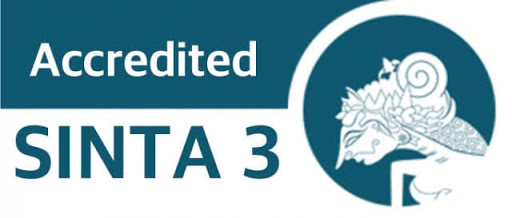ANALYZING EXPRESSIVE SPEECH ACTS OF THE MAIN CHARACTER IN THE JOKER MOVIE
Abstract
This research aimed to find out the types of expressive speech acts and the context of the expressive speech acts uttered by the main character in the Joker movie. The design of the research was descriptive qualitative research. The data source was the Joker Movie directed by Todd Phillips. The movie was released in 2019 and its duration was about 1 hour 55 minutes. The data of this research were utterances included as expressive speech acts. The data were collected by watching, observing, and writing down the utterances indicated as expressive speech acts found in the movie. The data were analyzed by using formal and informal methods. The data were presented by using a table (Formal method) and description (Informal method). The contexts of the utterances were analyzed by using SPEAKING model. The results of the analysis showed that there were six classifications of expressive speech acts uttered by the main character in the Joker Movie. The total number of expressive speech acts found in the movie was 27 utterances covering 7 utterances of greeting, 6 utterances of agreeing, 5 utterances of thanking, 4 utterances of apologizing, 3 utterances of wishing, and 2 utterances of exclamation. The researcher found that the expressive speech act of greeting was the most frequently used by the main character. It showed that the main character liked to express his salutation when he met someone.
Keywords
Full Text:
PDF (ENGLISH)References
Austin. (1962). How to Do Things with Words. Cambridge: Harvard University Press.
Agnesi, D. (2019). Expressive Speech Acts in The Drowning of Van Der Wijck Movie. Pesona Jurnal: Kajian Bahasa dan Sastra, 5(2), 62-72.
Aristidou, A. (2015). Emotion analysis and classification: understanding the performers’ emotions using the LMA entities. Computer Graphics Forum Journal, 34(6), 49-58.
Guiraud, N., Longin, D., Lorini, E., Pesty, S., & Rivière, J.(2011). The face of emotions: a logical formalization of expressive speech acts. Richland, SC: International Foundation for Autonomous Agents and Multiagent Systems.
Gusti, R, M. (2020). Expressive Speech Acts in Up in the Air Movie. Transformative Education and Educational Leadership Journal (AISTEEL), 214-217.
Hymes, D. (1974). Foundations of Sociolinguistics: Ethnographic Approach. Philadelphia: University of Pennsylvania Press.
Lindquist. (2015). The Role of language in emotion: Predictions from psychological constructionism. Frontiers in Psychological Journal, 6(4), 20-35.
Macagno, F. (2010). What we hide in words: Emotive words and persuasive definitions. Journal of Pragmatics, 42(7), 1997-2013.
Martinez, A. (2010). Speech Act Performance: Theoretical, empirical and methodological issues. Amsterdam: John Benjamins Publishing Company.
Norrick, N. (1978). Expressive Illocutionary Acts. Journal of Pragmatics, 2(3), 277-291. DOI: 10.1016/0378-2166(78)90005-X
Patton, M. (2002). A Guide to Using Qualitative Research Methodology. United Kingdom: Medecine Sans Frontiner (MSF).
Reisha, N. (2018). A pragmatic analysis of expressive speech acts in the movie venom. Vision: Journal for Language and Foreign Language Learning, 13(8).
Ronan, P. (2015). Categorizing expressive speech acts in the Pragmatically. Icame Journal, 39.
Rusiana. (2018). An analysis of speech act used in London has fallen movie. Vision: Journal for Language and Foreign Language Learning, 7(2), 160-169. DOI: 10.21580/vjv7i23022
Searle, J. R. (1969). Speech Acts. Cambridge: Cambridge University Press.
Searle, J. R. (1979). Expression and Meaning: Studies in the theory of speech acts. Cambridge: Cambridge University Press.
Sudaryanto. (1983). Metode dan Aneka Teknik Analisis Bahasa: Pengantar Penelitian Wahana Kehidupan Secara Linguistik. Yogyakarta: Duta Wacana University Press.
Syahidatul, H. (2016). An Analysis of the Expressive Speech Acts in Crazy Rich Asians Movie. Journal of English Language Teaching and Linguistics (JELTL), 11(1), 95-120.
Weigand, E. (2010). Dialogue: The Mixed Game. Amsterdam: John Benjamins Publishing.
DOI: http://dx.doi.org/10.33578/pjr.v6i1.8549
Refbacks
- There are currently no refbacks.
Copyright (c) 2022 JURNAL PAJAR (Pendidikan dan Pengajaran)

This work is licensed under a Creative Commons Attribution-NonCommercial-ShareAlike 4.0 International License.
JURNAL PAJAR (Pendidikan dan Pengajaran)
Secretariat
Program Studi Pendidikan Guru Sekolah Dasar
Gedung B1, FKIP Universitas Riau
Kampus Bina Widya Km. 12,5 Simpang Baru Panam
Pekanbaru Riau Indonesia 28293
e-mail : pajar@ejournal.unri.ac.id



